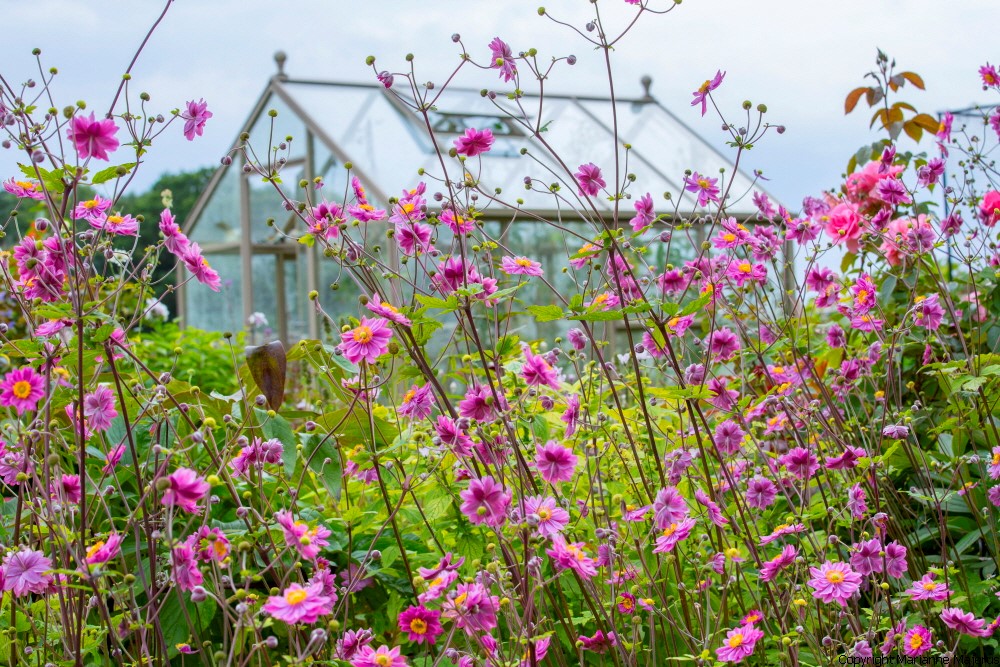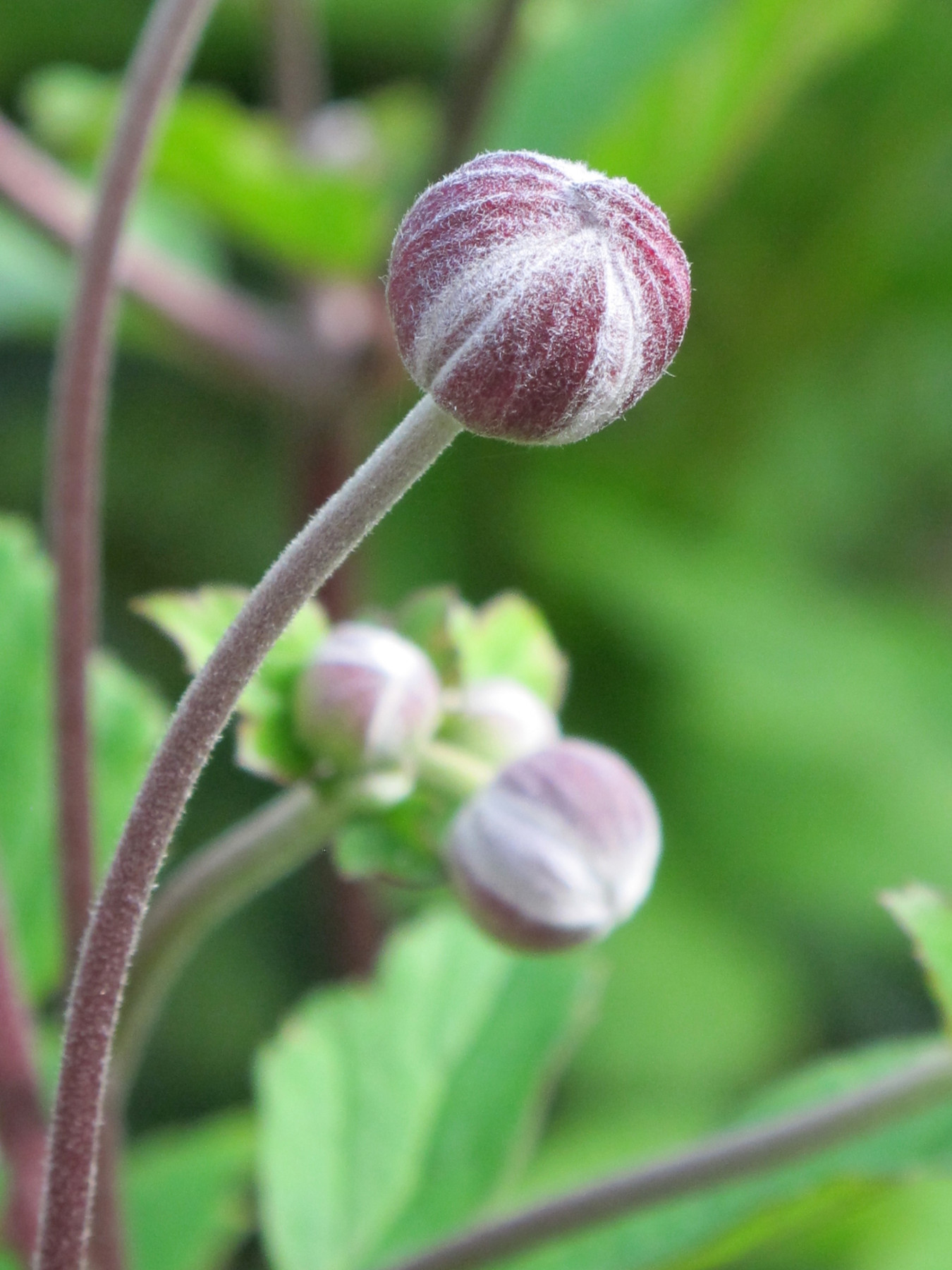
Many people ask me what I’m writing about at the moment and recently I wrote a general article on Japanese anemones for the RHS Garden magazine. The general response, when I mentioned Japanese anemones, was I wouldn’t grow those things because they pop up everywhere. The fact that they don’t stay in one clump – just where the gardener put them – was seen as a very bad thing indeed.
This judgement by so many experienced gardeners, or should that be control freaks, seemed very unfair on the Japanese anemone, for few plants produce long-lasting flowers that look so fresh just when the dog days of August are in full flow. My own rose and peony borders would be very dull without late-summer swathes of Anemone hupehensis var. japonica ‘Pamina’. This plant’s ability to plug the gaps among fading peonies, already hell bent on shabby dormancy, and roses getting ready for their last autumn flourish, saves the day and makes my heart sing!
Even before the semi-double, vivid-pink flowers of ‘Pamina’ begin to erupt in mid-August, this plant exudes a sleek charm. Dark stems rise up and the spherical buds, strung like grey seed pearls, wink at you in the border in July. And I can guarantee that some flowers will still be showing their bright-pink frilly form in late October, when most of the stems are full of pitted green seed capsules. Left to their own devices, these turn to cotton wool or kapok fluff, although I find myself trying to trim the stems back by late October before it happens. I’m also growing ‘Bowles’s Pink’, which has single flowers with six petals. The irregular, asymmetrical flowers have two smaller darker petals (which are really tepals) opposite each other. This, although almost as invasive, is an equally welcome addition.
They are both Japanese anemones, although the name is misleading. A. hupehensis is actually a native of Hupeh province in eastern China, although they’ve been grown in Japanese gardens for centuries. Plant hunter Robert Fortune (1812- 1880) collected a garden form of Anemone hupehensis in 1844, with reddish-pink, semi-double flowers, right at the end of his first voyage to China. Fortune saw it rambling over tombstones, in a shady churchyard in Shanghai, whilst plant hunting for the RHS and the East India Company. Japanese anemones are not averse to some shade and the Irish gardener and journalist William Robinson (1838 – 1935), who gardened at Gravetye Manor, describes using the single-white ‘Honorine Jobert’ in just this way in The English Flower Garden published in 1883. It will even do north-facing.

The late Christopher Lloyd (1921- 2006) of Great Dixter, surely the most sparkling garden writer of all, didn’t mind them rambling either. When he judged the Japanese Anemone trial held at RHS Wisley (1996-1997) he believed that ‘Robustissima’ was definitely AGM worthy due to its later-flowering, silver-pink single flowers. However ,he recorded (in Christopher Lloyd’s Garden Flowers) that it “filled the judging panel with visions of horror.” One of Christopher Lloyd’s fellow judges was Sybille Kreutzberger, once Head Gardener at Sissinghurst, and she has made her feelings plain about my excess of ‘Pamina’ when visiting me. “Where will it end up?” she asked.
E.A. Bowles (1865 -1954) had a similar problem with ‘Queen Charlotte’, now ‘Köningin Charlotte’. He admitted that it has “taken possession of rather more of the …. Rock garden than I desired, but it is so lovely that I cannot bring myself to root it out…” (from My Garden in Autumn and Winter) They don’t just spread, I believe the bee-friendly flowers produce can produce seedlings. The first recorded hybrid appeared in the RHS garden at Chiswick, pre-1849, and it was thought to involve Fortune’s introduction (A. hupehensis) and two Asian species, A. vitifolia and A. tomentosa. These hybrids, now called A. x hybrida, tend to produce paler, single flowers in September and October, four weeks later than the vibrant flowers produced by those with hupehensis in their name.
Other species anemones have a tendency to hybridise and this produced ‘Wild Swan’, a compact long-flowering, blue-backed white anemone with a clump-forming habit. Chosen as Chelsea Plant of the Year in 2011, it arose as a chance seedling on Elizabeth MacGregor’s Scottish nursery. Elizabeth explained that “it was originally selected in 2001/2 as an uncharacteristic seedling amongst a batch Anemone rupicola.” The plants had been propagated from collected seeds taken from plants that had been raised from seed acquired from NARGS, the North American Rock Garden Society. Roy Lancaster encouraged Elizabeth MacGregor to release ‘Wild Swan’ commercially, but this sterile plant has had to be micropropagated. More deliberate crosses have followed, including ‘Ruffled Swan’ and I find this easier to grow than ‘Wild Swan’. (from Hardy’s Cottage Garden Plants – www.hardysplants.co.uk
Japanese anemones also produce sports, shoots with different flowers etc. ‘Honorine Jobert’ AGM arose as a single stem on a pink clump of A. japonica ‘Elegans’ in the garden of the Jobert family’s garden in Verdun-sur-Meuse in north-eastern France. It was named after Honorine, their daughter, and it’s very special. Neatly arranged white sepals surround a pale-green button eye, ringed in golden sepals. The low-growing foliage is dark-green and it will often roam into shadier spots. It was introduced in 1858 by nurseryman Victor Lemoine of Lyon, the first foreign recipient of the VMH – the highest award given by the RHS.

My favourite, ‘Pamina’, was raised by Germany nurseryman Dr Hans Simon in 1983 and launched in 1988. It’s very hardy and neater than the more-vibrant ‘Prinz Heinrich’, which was raised by Wilhelm Pfitzer in 1902, and the shorter ‘Rotkäppchen’ (literally little red riding hood). Any Japanese anemone could ramble among hardy fuchsias, like ‘Mrs Popple’, in a narrow border and I’ve seen this used in many a garden. Or it could pop up round the deliciously plummy leaves of this smoke bush, Cotinus coggygria ‘Royal Purple’.
This is the only shrub in my autumn border and it hangs on to its leaves until late November, setting off various grasses and asters. It also frames the ultra-white daisy flowers of another rambling stray, Leucanthemella serotina. Clean white is tolerable in autumn light, although I can’t get away with any virginal white in summer because the light is too harsh in the upper reaches of The Cotswolds. White is a no-no colour for most of the year, but it works when framed by the dark claret-red leaves of the smoke bush in autumnal light. Some asters also travel freely and I have one lavender-blue with dark stems, named Symphyotrichum ‘Vasterival’, that is colonising the autumn border far too efficiently. Soon I will have to tug out the stems that have gone too far for, if I leave it until spring, I won’t be able to tell it apart from the others.
I’m not threatened by a rambling perennial, a plant that has a mind of its own, because they do find the gaps and pop up in unexpected places and that can be sheer delight. I am not the sort of gardener who aspires to micro-manage my plot, I like nature to intervene and provide some exuberant surprises, and Japanese anemones do just that!



